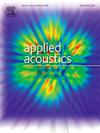The effect of frequency on the propagation of L (0, 1) guided waves in the prestressed strand anchorage segment
IF 3.4
2区 物理与天体物理
Q1 ACOUSTICS
引用次数: 0
Abstract
In prestressed anchorage systems, steel strands are typically encased within protective materials which restricts guided wave excitation from the external free segment. Effective assessment of internal strand integrity requires wave propagation through the anchorage segment. This study investigated the effect of frequency on the propagation characteristics of L (0, 1) guided waves in prestressed strand anchorage segments. Semi-analytical finite element models were developed for both the free and tensile segment of the steel strand to analyze the displacement distribution of the L (0, 1) guided wave within the frequency range of 80–320 kHz.. The results show that the energy of the L (0, 1) guided waves is more concentrated at the cross-section center in the outer helical steel wires with the increasing of the frequency. These phenomena indicates that the higher frequency L (0, 1) guided waves are less affected by the anchor constraint boundary conditions. To further investigate wave behavior in the anchorage segment, a finite element simulation model was established to investigate the transient propagation characteristics of L(0,1) guided waves through the anchorage. The simulation results show that the strong interface reflection echoes are induced when the L (0, 1) guided waves propagate through the anchorage segment from the free segment. In addition, due to energy leakage from the steel wire into the anchorage, a trailing leakage wave packet is generated after the guided wave passes through the anchorage. However, as the frequency of the L (0, 1) guided wave increases from 80 kHz to 320 kHz, both the reflection and leakage phenomena in the anchorage segment gradually diminish. Finally, a guided wave through-anchorage detection experiment was conducted, and the results demonstrated that the reflection coefficient reaches 0.57 at 80 kHz and decreases rapidly with increasing frequency to 0.12 at 200 kHz and then stabilizes. In contrast, the transmission coefficient shows a non-monotonic trend due to interference between leakage and transmitted waves, increasing from 0.37 to 0.45 in the 80–120 kHz range, decreasing to 0.17 between 120–240 kHz, and then recovering to 0.43 in the 240–320 kHz range, which aligns well with the simulation results. This study provides a basis for selecting guided wave modes and frequencies for detecting steel strand defects within anchorage systems.
频率对L(0,1)导波在预应力锚固段传播的影响
在预应力锚固系统中,钢绞线通常被包裹在保护材料中,这限制了来自外部自由段的导波激励。有效评估内链完整性需要波浪通过锚固段传播。本文研究了频率对L(0,1)导波在预应力锚固段中传播特性的影响。建立了钢绞线自由段和拉伸段的半解析有限元模型,分析了L(0,1)导波在80 ~ 320 kHz频率范围内的位移分布。结果表明:随着频率的增加,L(0,1)导波的能量更集中在外螺旋钢丝的截面中心;这些现象表明,较高频率的L(0,1)导波受锚约束边界条件的影响较小。为了进一步研究锚固段中的波浪行为,建立了有限元仿真模型,研究L(0,1)导波通过锚固段的瞬态传播特性。仿真结果表明,L(0,1)导波从自由段经锚固段传播时,会诱发强界面反射回波。此外,导波通过锚地后,由于钢丝的能量泄漏进入锚地,产生尾漏波包。但随着L(0,1)导波频率从80 kHz增加到320 kHz,锚固段的反射和泄漏现象逐渐减弱。最后进行导波通过锚固检测实验,结果表明:反射系数在80 kHz时达到0.57,在200 kHz时随频率增加迅速下降至0.12,然后趋于稳定。在80 ~ 120 kHz范围内,传输系数从0.37增加到0.45,在120 ~ 240 kHz范围内减小到0.17,然后在240 ~ 320 kHz范围内恢复到0.43,与仿真结果吻合较好。研究结果为锚系钢链缺陷的导波模式和频率选择提供了依据。
本文章由计算机程序翻译,如有差异,请以英文原文为准。
求助全文
约1分钟内获得全文
求助全文
来源期刊

Applied Acoustics
物理-声学
CiteScore
7.40
自引率
11.80%
发文量
618
审稿时长
7.5 months
期刊介绍:
Since its launch in 1968, Applied Acoustics has been publishing high quality research papers providing state-of-the-art coverage of research findings for engineers and scientists involved in applications of acoustics in the widest sense.
Applied Acoustics looks not only at recent developments in the understanding of acoustics but also at ways of exploiting that understanding. The Journal aims to encourage the exchange of practical experience through publication and in so doing creates a fund of technological information that can be used for solving related problems. The presentation of information in graphical or tabular form is especially encouraged. If a report of a mathematical development is a necessary part of a paper it is important to ensure that it is there only as an integral part of a practical solution to a problem and is supported by data. Applied Acoustics encourages the exchange of practical experience in the following ways: • Complete Papers • Short Technical Notes • Review Articles; and thereby provides a wealth of technological information that can be used to solve related problems.
Manuscripts that address all fields of applications of acoustics ranging from medicine and NDT to the environment and buildings are welcome.
 求助内容:
求助内容: 应助结果提醒方式:
应助结果提醒方式:


